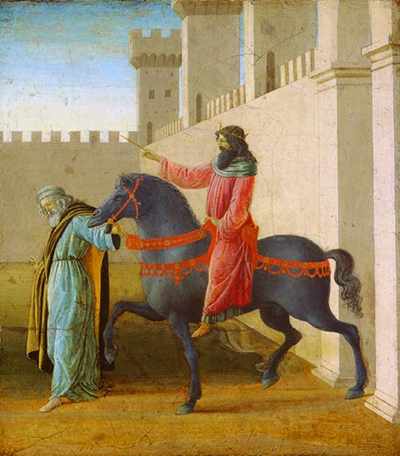Sandro Botticelli and Filippino Lippi would both contribute different artworks to produce a complete series which became known as Life of Esther or Scenes from the Story of Esther. Their respective work is believed to have been carried out in the 1470s.
In front of us here we find a gentleman on horseback, being led out by another figure, presumably one of his staff. The horse is decorated in a manner which implies its importance, and therefore suggests that the man riding him is also of great status. He holds his hand out, possibly displaying a sword in an apparent scene of celebration, as indicated by the title of the painting. The artist makes use of architecture in a dominant manner within this painting, with its stretching all the way down the right hand side of the composition, and then again across the background. Several turrets rise up to the right, though they seem somewhat small in comparison to the rest of the perspective. The entire genre of architecture within art was changing considerably during the Early Renaissance, aiming to replace the flat two-dimensional practises that were common before this. Botticelli was therefore pushing new ideas which would in turn develop over time across other artist's careers who followed on afterwards.
The Triumph of Mordecai can now be found in the National Gallery of Canda and is one of the few Botticelli paintings to have made its way out of Europe and the US. This important institution hosts several other related artworks from this artist's career and the overall collection is devoted to two main categories, namely Canadian and European art up to around the early 20th century. Naturally, they continue to add new items annually, and continue to count some of the most influential artists in history within their impressive selection of work. Painting is the dominant medium, with sculpture being much less apparent here, though even the building itself offers great interest from an architectural point of view. Some of the big names featured here alongside Botticelli include the likes of Rembrandt, Titian and El Greco, with many more besides to enjoy here.
This series of work differs from much of the rest of this artist's career, with some fairly plain scenes that lack the excitement and energy of the artist's biggest pieces. That said, there is still much to enjoy here and it is also interesting to see how he produced a series of work alongside another artist, and how they went about trying to create a consistent look throughout the different panels. They may also have made use of some of their assistants too, and so this turned into a fairly major project by the time that it was finished. Botticelli himself took on series of artworks from time to time, but most of his best work was from individual items in which he was perhaps more inspired and fresh of mind.




